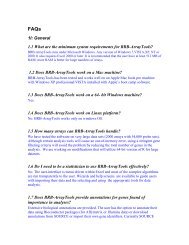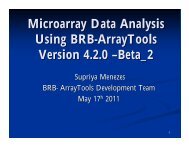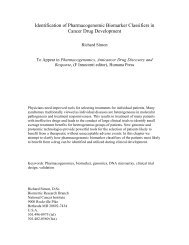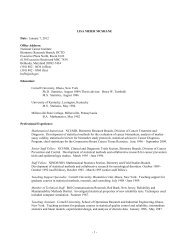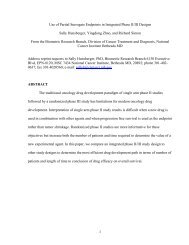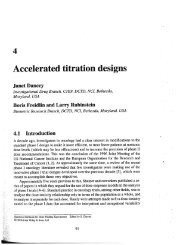form e = am −α+b with j=1, …, J. The estimates a , α <strong><strong>an</strong>d</strong> for the parameters aremjjobtained by minimizing the non-linear least squares functionJ∑j=1b { } 2mj−αje −am −b.The <strong>adjusted</strong> <strong>bootstrap</strong> estimate for the prediction error is given byABSe n = <strong>an</strong> −α+ b .It is the fitted value on the learning curve as if all original observations contributed to <strong>an</strong>individual <strong>bootstrap</strong> learning set.In practice, the choice <strong>of</strong> l c<strong>an</strong> r<strong>an</strong>ge from somewhere close to 1 to a value greater th<strong>an</strong> 5.Repeated leave-one-out <strong>bootstrap</strong> estimates typically have lower variability th<strong>an</strong> leaveone-outcross-validation. They have <strong>an</strong> upward bias that decreases <strong><strong>an</strong>d</strong> their variabilityincreases with the expected number <strong>of</strong> distinct original observations selected in <strong>bootstrap</strong>.Fitting <strong>an</strong> inverse power law curve to a series <strong>of</strong> repeated leave-one-out <strong>bootstrap</strong> valuesenables us to define a conservative estimate (not subject to downward bias) that providesa compromise between estimates with large variability <strong><strong>an</strong>d</strong> large upward bias. Inversepower law curve is a flexible way to model a learning process, <strong><strong>an</strong>d</strong> is quite typical indescribing machine learning, hum<strong>an</strong> <strong><strong>an</strong>d</strong> <strong>an</strong>imal learning behavior (Shrager et. al. [14]).Mukherjee et al. [15] studied sample size requirements in microarray classification usinga similar learning curve.4. COMPARISON OF METHODSIn this section, we compare the <strong>methods</strong> described in Sections 2 <strong><strong>an</strong>d</strong> 3 through simulationstudy <strong><strong>an</strong>d</strong> <strong>an</strong> application to a lymphoma dataset.4.1 Simulated DataSimilar simulated data sets are considered in Molinaro et al. [8]. For each simulateddataset, generate a sample <strong>of</strong> n patients, each with p genes (or features). Half <strong>of</strong> thepatients are in class 0 <strong><strong>an</strong>d</strong> half in class 1 divided according to disease status. Geneexpression levels are generated from a normal distribution with covari<strong>an</strong>ce10
matrix Σ= ( σ ij), i, j = 1,..., p, where the only nonzero entries are σ = 1 <strong><strong>an</strong>d</strong>σ = 0.2 with 0 < | i− j| ≤5. For class 0 patients, genes are generated with me<strong>an</strong> 0. Forijclass 1 patients, 1% <strong>of</strong> the genes are generated with me<strong>an</strong> µ1, 1% with me<strong>an</strong> µ 2<strong><strong>an</strong>d</strong> therest with me<strong>an</strong> 0.iiIn each simulation run, a prediction model is built on the sample <strong>of</strong> size n <strong><strong>an</strong>d</strong> tested on1000 independent data generated with the same structure. The resulting error rateestimates the true prediction error for the sample <strong><strong>an</strong>d</strong> is denoted by e n . For each method,we report the averaged estimate (Est.) <strong><strong>an</strong>d</strong> the st<strong><strong>an</strong>d</strong>ard deviation (STD) calculated acrossR=1000 simulation replications, as well as the averaged bias (Bias) <strong><strong>an</strong>d</strong> me<strong>an</strong> squarederror (MSE) with respect to the “true” prediction error e n . We have estimated thevariability (STD) <strong>of</strong> a method <strong>of</strong> estimating prediction error using simulation, but such avariability estimate would not be available for <strong>an</strong>alysis <strong>of</strong> a single dataset.For class discrimination, we consider in the simulation the diagonal linear discrimin<strong>an</strong>t<strong>an</strong>alysis (DLDA), the one nearest neighbor with Euclide<strong>an</strong> dist<strong>an</strong>ce (1NN) <strong><strong>an</strong>d</strong> theclassification <strong><strong>an</strong>d</strong> regression tree (CART). These algorithms are available through built-infunctions in the statistical package R [16]. Details <strong>of</strong> these R functions are described inMolinaro et al. [8]. For all <strong>methods</strong> reviewed in Section 2, we draw B = 100 <strong>bootstrap</strong>samples. Running 50 to 100 <strong>bootstrap</strong> replications is <strong>of</strong>ten considered more th<strong>an</strong> adequate(Efron <strong><strong>an</strong>d</strong> Tibshir<strong>an</strong>i [3, 4]). For the repeated leave-one-out <strong>bootstrap</strong> <strong><strong>an</strong>d</strong> the <strong>adjusted</strong><strong>bootstrap</strong>, we run B1= 50 <strong>bootstrap</strong> replications on every leave-one-out set <strong><strong>an</strong>d</strong> use themto predict for the left-out observation. This should be quite sufficient in <strong>comparison</strong> to theleave-one-out <strong>bootstrap</strong> method, in which B <strong>bootstrap</strong> replications provide about0.368B<strong>bootstrap</strong> samples not containing (<strong><strong>an</strong>d</strong> to predict for) a specific observation. The <strong>adjusted</strong><strong>bootstrap</strong> method is fitted onJ = 6 repeated leave-one-out <strong>bootstrap</strong> estimateswith l =0.75, 1,1.5,2, 3, 10, so that the number <strong>of</strong> original observations contributing to theresampled learning set spreads out across a reasonable r<strong>an</strong>ge for small sample problems.11



